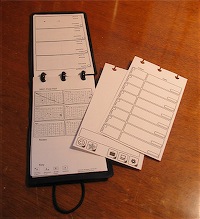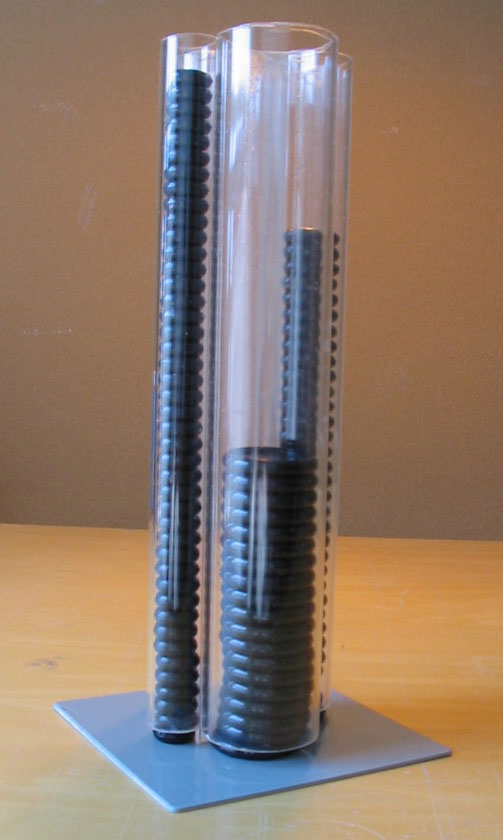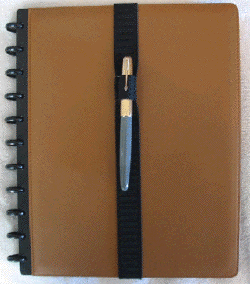 The strengths of the hPDA concept — ruggedness, reliability, and simplicity — derive from its preferred medium, the humble 3×5 card. But as hard as it is for me to admit, paper does have its limitations. Ink affixes the data to the storage medium statically, and in doing so it limits the user’s ability to manipulate the data.
The strengths of the hPDA concept — ruggedness, reliability, and simplicity — derive from its preferred medium, the humble 3×5 card. But as hard as it is for me to admit, paper does have its limitations. Ink affixes the data to the storage medium statically, and in doing so it limits the user’s ability to manipulate the data.
On the other hand, while electronic storage offers magnificent interactivity, the data manipulation and search experience can be more complex and intensive than on an index card. If only index cards could sort themselves!
 But until scientists figure out a way to manufacture smart 3×5 cards (and for any scientists reading this, there’s probably a Nobel Prize in it for you), here’s the best of both worlds — a quick hack for my wife’s Palm that blends the yin of a PDA with the yang of a hipster (or is it the other way around?). It uses three small Rollabind rings affixed to a sheet trimmed from a poly file folder, which is then slipped into the leather holder’s card pocket. A stylus with a built-in pen allows her to translate between the two with ease. The hPDA is perfect for shopping lists, quick reminders, and taking notes on the fly. The PDA manages her complex and ever-changing calendar.
But until scientists figure out a way to manufacture smart 3×5 cards (and for any scientists reading this, there’s probably a Nobel Prize in it for you), here’s the best of both worlds — a quick hack for my wife’s Palm that blends the yin of a PDA with the yang of a hipster (or is it the other way around?). It uses three small Rollabind rings affixed to a sheet trimmed from a poly file folder, which is then slipped into the leather holder’s card pocket. A stylus with a built-in pen allows her to translate between the two with ease. The hPDA is perfect for shopping lists, quick reminders, and taking notes on the fly. The PDA manages her complex and ever-changing calendar.
Now if I could only get her to use my hPDA templates…
 When I converted my freelance business files to a combination of Rollabind and Levenger’s Circa four years ago, I decided to store my Jotz notebooks disc-down in my filing cabinet, identified by their color-coded finger rings. When it came time to convert my inactive records to Circa, I opted for a hanging folder hack, identified by ordinary hanging-folder tabs.
When I converted my freelance business files to a combination of Rollabind and Levenger’s Circa four years ago, I decided to store my Jotz notebooks disc-down in my filing cabinet, identified by their color-coded finger rings. When it came time to convert my inactive records to Circa, I opted for a hanging folder hack, identified by ordinary hanging-folder tabs.
 Regular readers
Regular readers  I discovered Merlin Mann’s
I discovered Merlin Mann’s  Wrapping up my discussion of the three techniques I use to manage my freelance writing business, today I review how I’ve configured Apple’s Mail program to manage work e-mail.
Wrapping up my discussion of the three techniques I use to manage my freelance writing business, today I review how I’ve configured Apple’s Mail program to manage work e-mail. I rely on three things to administer my freelance writing business: paper files, electronic files, and e-mail. I’ve already written about how I use
I rely on three things to administer my freelance writing business: paper files, electronic files, and e-mail. I’ve already written about how I use  The Tuesday Hack is a little early this week because I couldn’t wait to introduce my weekend DIY project: a prototype Rollabind ring dispenser.
The Tuesday Hack is a little early this week because I couldn’t wait to introduce my weekend DIY project: a prototype Rollabind ring dispenser. The strengths of the hPDA concept — ruggedness, reliability, and simplicity — derive from its preferred medium, the humble 3×5 card. But as hard as it is for me to admit, paper does have its limitations. Ink affixes the data to the storage medium statically, and in doing so it limits the user’s ability to manipulate the data.
The strengths of the hPDA concept — ruggedness, reliability, and simplicity — derive from its preferred medium, the humble 3×5 card. But as hard as it is for me to admit, paper does have its limitations. Ink affixes the data to the storage medium statically, and in doing so it limits the user’s ability to manipulate the data. But until scientists figure out a way to manufacture smart 3×5 cards (and for any scientists reading this, there’s probably a Nobel Prize in it for you), here’s the best of both worlds — a quick hack for my wife’s Palm that blends the yin of a PDA with the yang of a hipster (or is it the other way around?). It uses three small Rollabind rings affixed to a sheet trimmed from a poly file folder, which is then slipped into the leather holder’s card pocket. A stylus with a built-in pen allows her to translate between the two with ease. The hPDA is perfect for shopping lists, quick reminders, and taking notes on the fly. The PDA manages her complex and ever-changing calendar.
But until scientists figure out a way to manufacture smart 3×5 cards (and for any scientists reading this, there’s probably a Nobel Prize in it for you), here’s the best of both worlds — a quick hack for my wife’s Palm that blends the yin of a PDA with the yang of a hipster (or is it the other way around?). It uses three small Rollabind rings affixed to a sheet trimmed from a poly file folder, which is then slipped into the leather holder’s card pocket. A stylus with a built-in pen allows her to translate between the two with ease. The hPDA is perfect for shopping lists, quick reminders, and taking notes on the fly. The PDA manages her complex and ever-changing calendar. Here’s a quick little hack that lets you park your hPDA and Circa 3×5 notes right in front of you while you work at your desk.
Here’s a quick little hack that lets you park your hPDA and Circa 3×5 notes right in front of you while you work at your desk. I’ve never been a big fan of the stitched-on pen loops that come with many daily planners, pad holders, and upscale notebooks like the Circa Leather Foldover. I find that when the notebook’s open, they get in the way; when the notebook’s closed, they keep the book from closing all the way.
I’ve never been a big fan of the stitched-on pen loops that come with many daily planners, pad holders, and upscale notebooks like the Circa Leather Foldover. I find that when the notebook’s open, they get in the way; when the notebook’s closed, they keep the book from closing all the way.